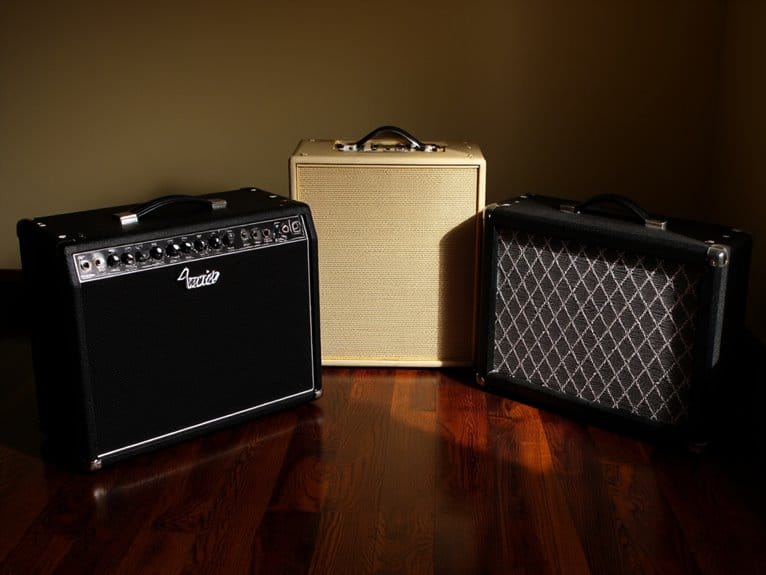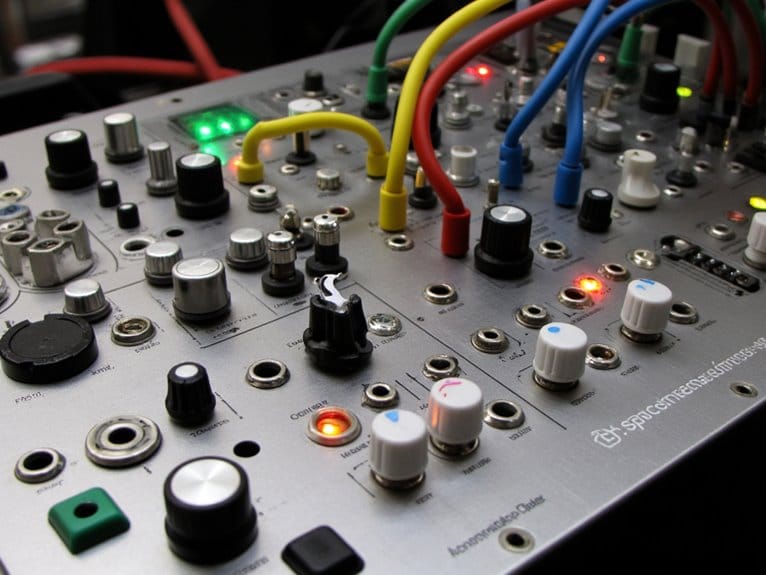Understanding Amp Voicing: Marshall vs. Fender vs. Vox
You’ll notice Marshall amps deliver aggressive midrange punch that cuts through dense mixes, making them perfect for rock and metal with their harmonic-rich distortion character. Fender amplifiers emphasize bright highs and firm lows while scooping the mids, creating that clean, bell-like clarity that defines country and blues tones. Vox amps produce their signature “chime” through EL84 tubes and upper midrange sparkle, delivering glassy highs without harshness. Understanding these voicing differences will transform how you approach amplifier selection for your specific musical goals.
We are supported by our audience. When you purchase through links on our site, we may earn an affiliate commission, at no extra cost for you. Learn more.
Notable Insights
- Marshall amps emphasize aggressive midrange presence and upper-midrange frequencies, delivering harmonic-rich distortion ideal for rock music.
- Fender amps provide clean, bright tones with reduced midrange, emphasizing sparkling highs and firm low-end for bell-like clarity.
- Vox amps are renowned for their distinctive “chime” character, featuring glassy, bell-like clarity through EL84 tubes and EF86 preamp stages.
- Each amp voicing caters to different musical styles: Marshall for rock aggression, Fender for clean versatility, Vox for jangly brightness.
- Understanding these voicing differences helps guitarists select amplifiers that complement their playing style and desired tonal characteristics.
What Amp Voicing Means and Why It Matters for Your Tone
When I first started diving deep into amplifier design, I’ll admit I used to think amp voicing was just marketing jargon-until I plugged the same guitar into a Marshall JCM800 and then a Fender Twin Reverb, both set to identical gain and EQ settings, and heard two completely different sonic personalities emerge from what should’ve been the same signal chain.
I used to dismiss amp voicing as marketing speak until I heard identical settings produce completely different tones.
That’s when I understood voicing significance goes far beyond simple frequency response curves.
Your amplifier’s voicing defines how it interprets and colors your guitar signal, affecting harmonic content, dynamic response, and distortion character through its preamp design, tone stack positioning, and power tube selection.
These tonal nuances determine whether your amp sounds bright and chimey, warm and scooped, or aggressively midrange-forward, fundamentally shaping how your playing style translates into the final sound that reaches your audience’s ears. Modern amplifiers often incorporate digital modeling technology to recreate these classic voicing characteristics with remarkable accuracy. This allows musicians to experiment with a wide range of tonal options without needing to own multiple amplifiers. Additionally, amp modeling technology explained provides insights into how these digital processes mimic the sound and feel of analog gear, making it accessible for players to achieve professional-quality tones in various settings. As a result, guitarists can explore new styles and expressions, enhancing their creativity and performance versatility.
Understanding these voicing differences becomes crucial when selecting the right amplifier, as speaker size also plays a significant role in determining your overall tone character and frequency response.
Marshall’s Aggressive Mid-Forward Character
The brutal honesty of Marshall’s midrange aggression hits you the moment you crank up any JCM800 or Plexi-there’s no polite scooped-mid sweetness here, just an unapologetic wall of upper-midrange frequencies that’ll cut through the densest band mix like a chainsaw through butter.
This midrange punch isn’t just EQ shaping; it’s fundamental circuit design that creates that signature sonic aggression rock players crave.
While Fender amps scoop their mids and emphasize bass-treble sparkle, Marshall’s two-channel blending pushes those aggressive midrange frequencies forward, creating harmonic-rich distortion that maintains clarity even when saturated.
You can’t replicate this character with simple EQ pedals because Marshall’s voicing involves complex power amp and speaker interactions that define the brand’s legendary presence.
Fender’s Clean Bright Sound With Scooped Mids
While Marshall’s midrange aggression dominates rock stages worldwide, Fender’s approach to amp voicing couldn’t be more different-it’s built around that legendary clean, bright sound with scooped mids that’s defined American guitar tone for over seven decades.
When you dial in a Fender amp, you’re experiencing a carefully engineered frequency response that emphasizes bright highs and firm low end while reducing midrange presence. This creates that signature “bell-like” clarity where every note rings with crystalline precision, whether you’re playing complex jazz chords or simple country licks.
| Pickup Position | Tonal Character |
|---|---|
| Neck | Warmer, rounded clean tones |
| Middle | Balanced, chimey “funky” sound |
| Bridge | Brightest, most biting clarity |
| Neck + Middle | Nuanced warmth with sparkle |
| Middle + Bridge | Enhanced brightness with body |
The bright cap capacitor boosts treble frequencies at lower volumes, maintaining that sparkle even when you’re practicing at home.
Vox’s Distinctive Chiming and Glassy Highs
Step into any studio where a Vox AC30 fires up, and you’ll immediately hear why the “Vox chime” has captivated guitarists from The Beatles to modern indie rockers-it’s that unmistakable glassy, bell-like clarity that cuts through dense mixes without ever sounding harsh or metallic.
The secret lies in Vox’s EL84 power tubes paired with EF86 preamp stages, creating a unique harmonic interaction that produces those signature jangly highs.
Unlike Fender’s scooped approach, Vox delivers tonal clarity through its distinctive upper midrange sparkle, enhanced by the inverse “tone cut” control that smooths harsh frequencies rather than boosting treble.
When you pair this circuitry with Celestion Blue speakers, you’re getting the full synergy that made British Invasion bands sound so distinctive-that characterful, colored tone that Jennings originally designed for musical personality over technical neutrality.
On a final note
Now that you’ve explored Marshall’s mid-heavy aggression, Fender’s scooped brightness, and Vox’s crystalline chime, you’re equipped to match your playing style with the right amp character. I’ve found that understanding these fundamental voicing differences saves countless hours of frustration when dialing in tones. Whether you’re chasing vintage authenticity or modern versatility, these sonic blueprints will guide your amp selection and help you achieve the specific tonal palette you’re after. Consider how a combo guitar amp can enhance your setup by combining portability with distinct tonal options, making it a versatile choice for various playing situations. Experimenting with different speaker configurations and wattage can further refine your sound, allowing you to find the perfect balance for on-stage performances or home practice. Ultimately, the right combo guitar amp can elevate your playing experience and help you unlock your full creative potential.






